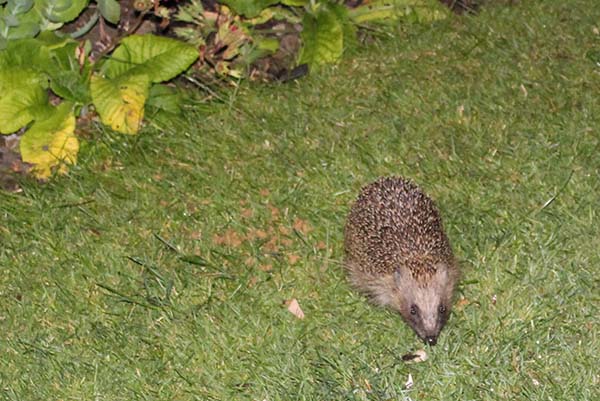Ironic that it was Hedgehog Awareness Week last week, because here in our small back garden in Hampshire we have been becoming increasingly hedgehog aware. It started as a bit of a mystery. Every morning we would find the cage on top of our bird ground feeder knocked askew, and the remains of the birds’ mealworms and suet devoured. A ratty visitor perhaps?
Who’s poo?
But then, more distinct telltale signs: shiny black droppings, not just one or two, but tens of poops around the lawn. Most of the literature on hedgehogs states that their stools are distinctly cylindrical, sometimes slightly tapered at one end and about 5cm in length, but I can confirm that hedgehog poop comes in all shapes and sizes, and in vast quantities.
In the flesh
And then we finally caught the culprit in the act. Instantly recognisable – short tail, long legs, small ears, pointed furry face, small black eyes … a lot of spines … and terrible table manners! Those of you who follow this blog will know that our last sighting of a hedgehog was back in the summer of 2015 (see Huffing Hedgehogs), so you can imagine our excitement.
We immediately got down to the serious business of leaving the right food out.
Feeding hedgehogs
Hedgehogs are omnivores but over 70% of their natural diet comprises beetles and other insects, worms and a tiny number of slugs and snails. You can supplement their evening dinner with:
- Meaty cat or dog food
- Specific tinned or dry hedgehog food, available from garden centres and pet shops
- Cat biscuits
And if the guzzling in our back garden is anything to go by, they will appreciate it!
Do not give them:
- Bread or milk – they can’t digest them!
- Salty meats such as bacon or corned beef
- Dried mealworms. Although they are a good source of protein, they have a poor calcium: phosphorus ratio. Too little calcium/too much phosphorus can lead to metabolic bone disease (which is on the increase in hedgehogs) so it is best to avoid them completely. A healthy calcium: phosphorus ratio is 1:1 or 1:2.
And make sure you provide:
- Water (no other liquid refreshment) – they drink a lot!
- A sloping exit out of ponds so they can get out if they fall in.
Lawn of many hedgehogs
So, for the past 4 weeks we have been putting the food direct onto the lawn after dark between 9 and 10pm, when there are fewer marauding moggies around to sneak a crafty snack. This seems to have encouraged more hedgehog visitors to the garden, and as they are not territorial they seem to be content to share the food without too much squabbling. In fact, we have now seen up to four hedgehogs together at any one time on the lawn.
Even if they are not around on the lawn, then we can usually hear them through the night, either huffing at each other in our herbaceous borders or in our neighbour’s garden. Yes, the courting rituals have started (hedgehog breeding season is April through to September) and we have our fingers crossed for hoglets later this summer.
Look after your hedgehogs
Hedgehog numbers in the UK are continuing to decline. According to the People’s Trust for Endangered Species (PTES) 1 in 3 of all British hedgehogs have been lost since the year 2000. They are on the endangered species list, so if you find them in your garden, look after them!
For more information on hedgehogs go to The British Hedgehog Preservation Society, The Mammal Society, Prickles Hedgehog Rescue or Tiggywinkles Wildlife Hospital.
Do you have hedgehogs in your garden? I’d love to hear from you. Leave a comment below or let me know on Twitter @15greenmins




Have been trying to make a wildlife friendly garden since moving here a year ago . Didnt manage to get a hedgehog house put in site made for it but …. watering g plants this am and found trail of hedgehog poo on lawn. Will put out water and food tonight. Love hedgehogs.